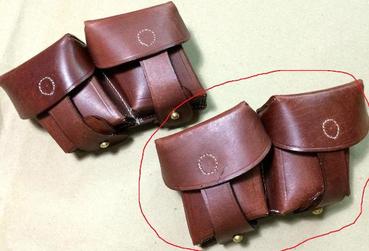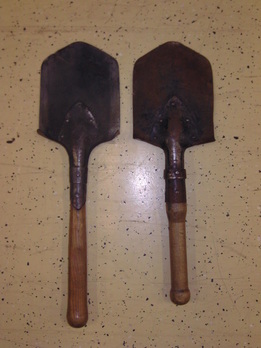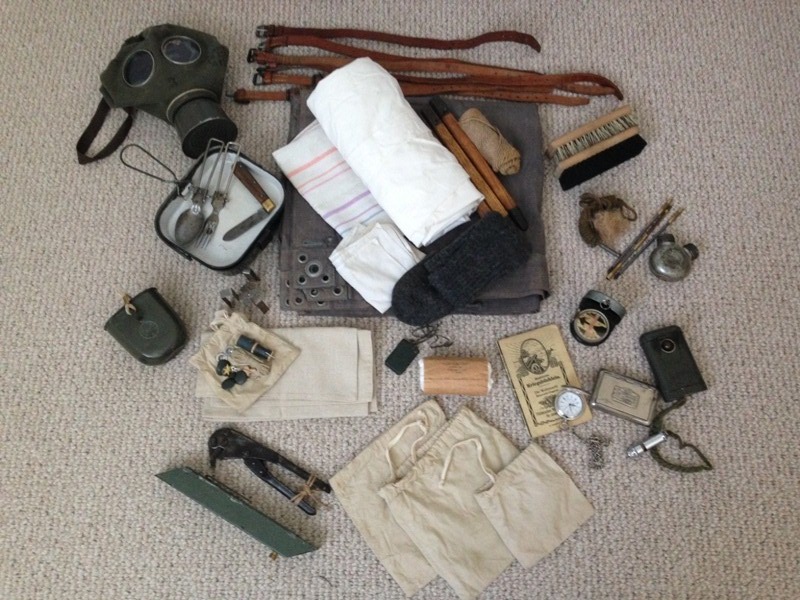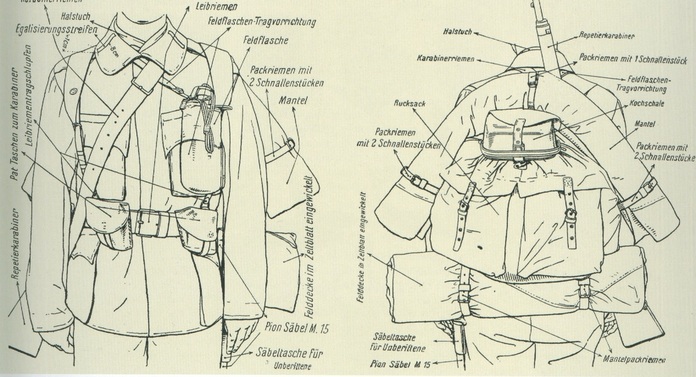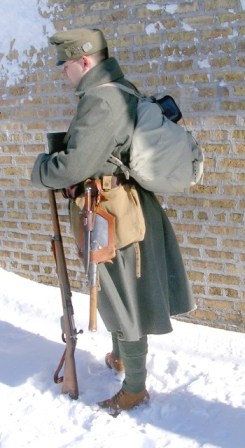Austrian M.1917 helmet
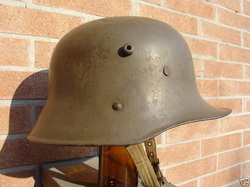
The Austrian army began receiving first shipments of German M16 helmets in November of 1916.When the war ended, 500.000 helmets from German factories were received. In 1917 production of the Austrian model (see picture) was under way and by the end of the war the Austro-Hungarian army received over 500.000 domestically made M16 helmets. Main diffrences between German and Austrian helmets were color, xhistrap and placement of rivets holding chinstrap attachments.
Steel helmet is required by GWA safety regulations. Therefore, it is necessary piece of gear and every member of the unit must have one, either original or steel reproduction.
Steel helmet is required by GWA safety regulations. Therefore, it is necessary piece of gear and every member of the unit must have one, either original or steel reproduction.
Austrian M.1917 "Bernforder" helmet
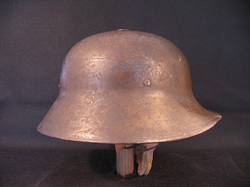
Additionally, over 140.000 Austrian made “Berndorfer” type helmets supplemented the Austro-Hungarian army. This helmet was developed in Berndorfer metal manufacturing company. However its production came too late and soon it was replaced by Austrian made copies of German helmets.
Original helmets are extremely hard to find and very expensive. However, there are reproductions coming out of Czech Republic.
Original helmets are extremely hard to find and very expensive. However, there are reproductions coming out of Czech Republic.
It is important to keep in mind that as we wear our helmets in the trenches and field, one should purchase a "reenacting grade" helmet. Ideally one should buy a helmet with post-war or no paint which can be accurately restored, or to buy an already restored helmet. Helmets with original paint should be avoided for two reasons, they do not look correct (helmets were issued new) and one must avoid the risk of damaging a valuable historical piece, it is better to leave these in your collection at home. If there is any question always ask before making a purchase.
Ammo pouches (M.1908)
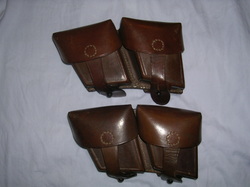
The most common type of pouches used during WW1 were ammo pouches for M.1895 rifle. Those pouches have only two compartments and held 20 rounds of ammunition each (total 40 rounds). The angular shape of the pouches was due to Mannlicher type of ammo clips. Flaps closed both compartments and closing strap was sewn to the flap in a circular pattern. Sometimes closing straps were simply riveted to the flap by two rivets. On the back of the pouch were two straps, which allowed belt to be pulled through, those straps were attached to small studs on the bottom of the ammo compartment. There was also a "D" ring attachment for backpack hooks. Pre war and early war pouches have an offset back, late war or post war pouches have straight back. Austro-Hungarian ammo pouches were used for decades after the war by successor states, and today they are hard to find collectibles.
After WW2 for a very brief period, Austrians produced those pouches again and today those still could be found in almost pristine condition. Most are stamped with dated/number “1951” inside of the closing flap.
No Bulgarian pouches can be used. Only correct reproductions or post WW2 original pouches.
WARNING!!!
Just recently some vendors started offering new repro ammo pouches at very attractive price. However, there is a major flaw with this pouch set. They made left and right pouch! In fact there was only one pouch and it was universal. Please do not make mistake purchasing this fantasy set. If you show up at the event with such set you will be asked to remove the incorrect pouch.
After WW2 for a very brief period, Austrians produced those pouches again and today those still could be found in almost pristine condition. Most are stamped with dated/number “1951” inside of the closing flap.
No Bulgarian pouches can be used. Only correct reproductions or post WW2 original pouches.
WARNING!!!
Just recently some vendors started offering new repro ammo pouches at very attractive price. However, there is a major flaw with this pouch set. They made left and right pouch! In fact there was only one pouch and it was universal. Please do not make mistake purchasing this fantasy set. If you show up at the event with such set you will be asked to remove the incorrect pouch.
M.1898 Breadbag
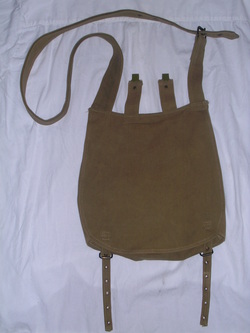
Austrian bread bag in size was similar to German WWI bread bag; however, there were few peculiarities that made those bread bags unique. First thing that strikes us right away is the permanently attached carrying sling. One side of the sling is sewn to the bag and the other is being adjustable by means of roller buckle. On the top of the bag there are also two hooks for attaching the bag to the belt. I have never seen any pictures indicating that bread bag was attached only by hooks to the belt. Inside of the bread bag there were two compartments for personal belongings, food as well as pocket for canteen. Late war or 'ersatz' models did not have a second compartment or canteen pocket. Most of the bread bags should have some stamps inside. Bread bags were made of heavy canvas and all hardware was or rather should be painted black. Colors of the canvas varied, early war examples were made of brown canvas however as the war progressed color of the bread bag changed to khaki, field-gray and gray and any imaginable shades of those colors! Each unit member must have bread bag.
M. 1910 Entrenching tool
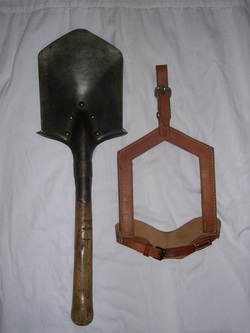
Originally, Austrian shovels copied what is commonly known as Lineman entrenching tool but by 1910 a new model was introduced that differed slightly from its predecessor. The top of the shovel was pointed not flat. At the beginning of the war both types of shovel were used but by the end of 1915 old style shovels were completely replaced by the new model. Some shovels were made with saw tooth on one side; however this was discontinued because such small saw had little value. After the war Austrian style shovels were used by Czechoslovaks, Poles, Hungarians and Austrians some of the shovels were even reissued to Wehrmaht and saw service in WWII! All shovels were issued with carriers; there were at least two models of leather carriers and at least two ersatz (pressed metal and heavy woven fabric with leather reinforcements) Shovels were normally carried on the left hip usually strapped together 'in German manner' with bayonet. During long marches the shovels were attached to backpack/rucksack in many different manners.
*Please refrain from purchasing post WW2 Hungarian M.1950 shovels that are being advertised as "Austro-Hungarian E-tools". The M.1910 style E-tool pictured here is the only acceptable model of E-tool permitted for use.
Please see comparison between the two shovels, M.1910 on the left and M.1950 on the right:
*Please refrain from purchasing post WW2 Hungarian M.1950 shovels that are being advertised as "Austro-Hungarian E-tools". The M.1910 style E-tool pictured here is the only acceptable model of E-tool permitted for use.
Please see comparison between the two shovels, M.1910 on the left and M.1950 on the right:
M 1888 and M.1915 Belts
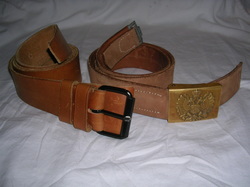
Austro-Hungarian army (with the exception of cavalry) entered the war with a brown (sometimes black) leather belts with brass buckles bearing Imperial or Hungarian crest. Most sources call this type of belt “Model 1888”. The construction of the belt was very similar to the German counterpart from that period. Belt buckles were made of brass and as brass became strategic resource by mid 1915, the Imperial decree abolished belts with brass buckles in favor of simplified pattern belt. However, both troops and NCOs were privately purchasing buckles from private manufacturers and this type of belt and buckles was used till the end of the war.
Second type of belt in use by Austro-Hungarian army was simple leather belt with adjustable roller buckle, sometimes referred to as “M.1915”. Originally, those were used by mounted troops prior to WWI but as brass became scarce it was decided that this type of belts would replace M.1888 belts. Early winter months of 1914 proved to be the most difficult time for the Austro-Hungarian war industry, when lack of production capacities and raw materials forced army to introduce several “ersatz” types of gear. One of the new “ersatz” items introduced were “replacement” belts with roller buckle made of heavy canvas; those were however issued mostly to non-combat units after 1915.
Second type of belt in use by Austro-Hungarian army was simple leather belt with adjustable roller buckle, sometimes referred to as “M.1915”. Originally, those were used by mounted troops prior to WWI but as brass became scarce it was decided that this type of belts would replace M.1888 belts. Early winter months of 1914 proved to be the most difficult time for the Austro-Hungarian war industry, when lack of production capacities and raw materials forced army to introduce several “ersatz” types of gear. One of the new “ersatz” items introduced were “replacement” belts with roller buckle made of heavy canvas; those were however issued mostly to non-combat units after 1915.
Gas mask and carrying canisters
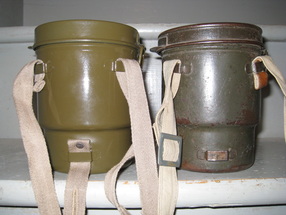
Austrians began experimenting with gas masks as early as 1915. However none of the domestically made gas masks proved to be adequate, although few of them were very interesting in design. Instead, military authorities relied on German models. Starting from 1915 Austro-Hungarian army received over 800.000 German made "Gummi' masks. While receiving shipments of German made gas masks, Austro-Hungarians tried to produce its own improved version of German 'Gummi' mask. Due to material shortages Austrians tried to use rubberized silk for mask production, unfortunately, masks proved to be too fragile for front line use and saw only limited use. During 1917/18 Austro-Hungarians began receiving German leather masks. Over 140.000 were imported from Germany before the end of hostilities. Austro-Hungarians introduced its own canisters for gas masks (see picture). Initially gas masks were carried in canvas carriers, however this type of carrier proved to be insufficient to protect mask from damages in the trenches, therefore tin cans were introduced. First model had a bottom slightly smaller then top there was also second model that was similar to German type can and this one was most likely used with German leather masks. Carrying straps were either canvas or paper cloth. Photographic evidence exists, showing troops carrying gas mask canister slung over the shoulder with simple string. Spare filters were carried in small cloth bags attached to the belt. Our unit permits use of all types of German gas masks; however, we prefer metal canisters instead of canvas carrying bags. Currently excellent reproductions of Austrian styles canisters became available from Czech vendors.
M. 1895 Bayonets
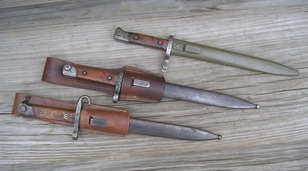
M.1895 Mannlicher rifle bayonet: this type of bayonet is most commonly encountered. Bayonet was issued with metal scabbard. Per war scabbards were painted black however during the war scabbards were painted olive green, dark green or event light gray. M.1895 Mannlicher NCO: this bayonet differs from regular bayonet by bent quilion and small metal ring attached to the pommel (accommodation for NCO/Officer knot) those are for NCOs only. This type of bayonet should be used only by ranks of zugsfuhrer and up. M.1895 Carbine bayonet: this bayonet was equipped with extra "sight" on the muzzle ring. This bayonet was made in both enlisted and NCO versions. If you want to be 100% correct when you are using carbine for reenacting you should look for this type of bayonet.
M.1917 Trench knives
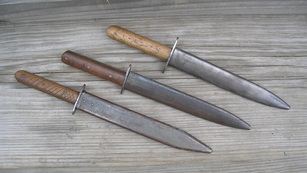
M.1917 trench knife is usually associated with Storm Troops however; it was being widely issued also to the line infantry. This was very simple, yet very effective weapon, basically a knife with a wooden handle and metal scabbard painted in oliver green or dark green. Leather or cloth loop was attached to the scabbard. This knife was usually carried on the left side before the bayonet. The use of M.1917 trench knife is permitted and encouraged in the unit.
M.1888/15 canteen
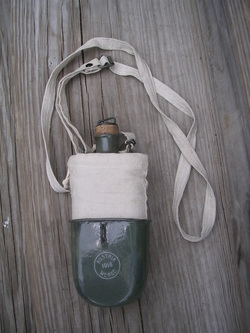
The most common canteen that you will find is enameled steel 0.5 l bottle. The unofficial name of the canteen used by collectors is M.1888/15. This canteen was enlarged version of M.1888 canteen. Almost all of them will be stamped with either “Austria”, “BGB Brün”, "Ligetfalu" or other manufacturers name and date (anything between 1915 to1918). After WW1 Czechoslovaks continued to manufacture this type of canteen, the only differences are the year of production, makers name stamped on the body and color of enamel.
During the war dismounted troops started using covers and carries for all types of canteens. There were many types of “home made” covers made of wool, canvas, and linen for canteens, some were sew on permanently some were made with string for tightening covers grip on the body of the canteen. But many canteens were carried with out any covers. All mounted troops prior to the war were issued with a “skeletal” type carrier made of leather for M.1888 canteens. There is little evidence that mounted troops canteen carriers were in widespread use in infantry. The most common type of canteen carrier in use by infantry showed up some time in early 1915 (perhaps even earlier). The carrier was made of narrow straps attached to the canteens carrying loops. The length of the straps could have been adjusted by small buckle. Besides official carriers there were dozens of improvised ones. Medical personnel were sometimes using carriers that hold two M.1888/15 canteens. During the war new model of medical canteen was introduced. The new canteen visually was the same as M.1888/15 but it was larger it could hold 1 liter of fluids. All canteens were issued with a cork stoppers, sometimes replaced with a simple wooden plug, a cup was fastened to the canteen’s bottom with a string that attached to the neck of the canteen.
During the war dismounted troops started using covers and carries for all types of canteens. There were many types of “home made” covers made of wool, canvas, and linen for canteens, some were sew on permanently some were made with string for tightening covers grip on the body of the canteen. But many canteens were carried with out any covers. All mounted troops prior to the war were issued with a “skeletal” type carrier made of leather for M.1888 canteens. There is little evidence that mounted troops canteen carriers were in widespread use in infantry. The most common type of canteen carrier in use by infantry showed up some time in early 1915 (perhaps even earlier). The carrier was made of narrow straps attached to the canteens carrying loops. The length of the straps could have been adjusted by small buckle. Besides official carriers there were dozens of improvised ones. Medical personnel were sometimes using carriers that hold two M.1888/15 canteens. During the war new model of medical canteen was introduced. The new canteen visually was the same as M.1888/15 but it was larger it could hold 1 liter of fluids. All canteens were issued with a cork stoppers, sometimes replaced with a simple wooden plug, a cup was fastened to the canteen’s bottom with a string that attached to the neck of the canteen.
M.1909 canteen
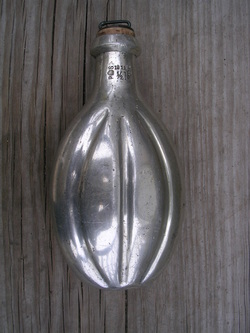
The other commonly encountered type of canteen was new M.1909 canteen made of aluminum. It is characterized by “pear” shape with groves going along its body. Those were issued prior to WWI and were going to replace older models, namely antique M.1869 and small M.1888 canteens. However its production was abandoned shortly after the war started. I'm not aware of any covers as well as cups for this type of canteen
M.1899 mess kit
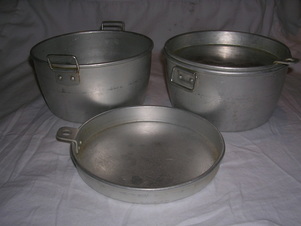
There were two types of mess kits that were issued to the troops during the war.
First model is M.1899 it had shape of a bowl with two small handles on each side and eating rounded plate that was also used as a lid for the mess kit. M.1899 type mess kits were issued with fabric cover fastened by a draw string. War time mess kits were made of enameled steel. Per war examples were made of tin plated steel. Some mess kits were stamped with maker logo on enameled body, some were not. After WWI Czechoslovaks and Austrians continued production of this type of mess kits with slight modifications. Currently reproductions of war time enameld version are being offered from vendors in Czech Rep.
First model is M.1899 it had shape of a bowl with two small handles on each side and eating rounded plate that was also used as a lid for the mess kit. M.1899 type mess kits were issued with fabric cover fastened by a draw string. War time mess kits were made of enameled steel. Per war examples were made of tin plated steel. Some mess kits were stamped with maker logo on enameled body, some were not. After WWI Czechoslovaks and Austrians continued production of this type of mess kits with slight modifications. Currently reproductions of war time enameld version are being offered from vendors in Czech Rep.
M.1912 mess kit
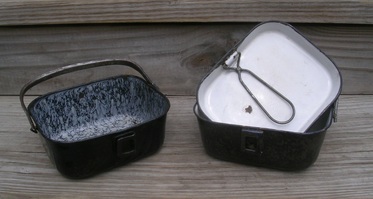
Second model of mess kit, was introduced in 1912 and it was intended to replace older models of mess kits still being in use.
The M.1912 mess kit was made of two pieces, the actual mess kit, wich was rectangular in shape with metal carrying handle and flat plate with wire handle that also served as mess kits lid. Mess kit’s carrying handle usually carries manufacturer’s marks. What is very interesting and peculiar to this type of mess kit that on the sides of the kit there is a rail/connector for joining together several mess kits or for inserting a bayonet in it and using it as a handle when mess kit was too hot to keep it in the hand! As was the case with earlier model pre war mess kits were made of tin pleated steel while almost are war dated mess kits were made of enameled steel.
The M.1912 mess kit was made of two pieces, the actual mess kit, wich was rectangular in shape with metal carrying handle and flat plate with wire handle that also served as mess kits lid. Mess kit’s carrying handle usually carries manufacturer’s marks. What is very interesting and peculiar to this type of mess kit that on the sides of the kit there is a rail/connector for joining together several mess kits or for inserting a bayonet in it and using it as a handle when mess kit was too hot to keep it in the hand! As was the case with earlier model pre war mess kits were made of tin pleated steel while almost are war dated mess kits were made of enameled steel.
Zeltbahn
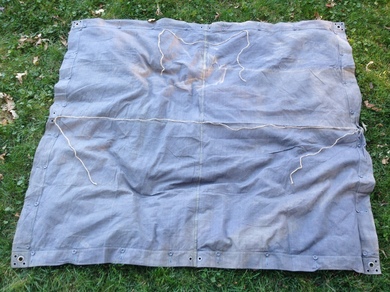
German model Zeltbah. Due to lack of readily available reproductions of appropriate KuK zelbahn German model is permitted for future use. German model zeltbahn was put to use by KuK army around 1917. German model proved to be faster and cheaper in mass manufacturing.
Other items
